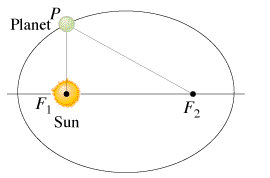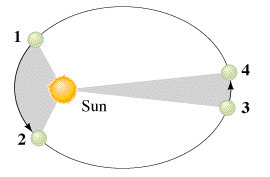The Secret of the Planets
After the fall of the Roman Empire, no progress was made in theoretical astronomy until the 1500's. Why this progress, when it finally came, occurred in Christian Europe (and not in the much wealthier empires of the Middle East, India, or China) is a very good question. The Judeo-Christian tradition of debating the meaning of written scriptures may have contributed to an atmosphere in which the rediscovered knowledge of the ancient world could be closely scrutinized and debated more vigorously than elsewhere. Also, the "work ethic" of the Christian world-view accorded more dignity and social acceptance to nobility who chose to spend their time on intellectual and/or practical matters than was true outside Europe, and this may have had a positive effect.
In any case, in 1543 Mikolaj Kopernik (Latinized name: Copernicus) published De Revolutionibus Orbium Celestium (On the Revolutions of the Celestial Orbs), in which he proposed that all the heavenly bodies revolved around the Sun, rather than the Earth. We should note two facts about this theory:
- Like the Ptolemic (Earth-centered theory), it assumed the planets to move in perfect circles, in uniform circular motion. It also used epicycles.
- The Copernican model did not work much better than the Ptolemic, in terms of actually predicting where the planets would be.
In view of this, what was it that (some) people found attractive about the Copernican model? Well, the Copernican model was simpler, in that it used considerably fewer epicycles than did the Ptolemic model. It also used only the classic epicycles, i.e., those rotating around a central axis and centered on the main circle, rather than the collections of off-axis and noncentered circles that the Ptolemic model had come to include. (Indeed, some scholars believe that one reason Copernicus discarded the Ptolemic model was a desire to move back to a model which more closely corresponded to the classic Greek principle of uniform circular motion.)
More importantly, however, the Copernican model provided an intuitive physical picture which explained the overall features of planetary motion. For example, the Ptolemic model had no particular explanation for why Mercury and Venus are never seen more than a certain angular distance from the Sun, whereas Mars, Jupiter, and Saturn can be seen at any angular distance. It was "just the way the epicycles worked out". Copernicus, on the other hand, said that Mercury and Venus orbited between the Earth and Sun -- whereas the other planets had orbits outside that of Earth, thus providing a much more satisfactory explanation. Also, by observing the degree of retrograde motion for each planet, one could determine the relative distance of each one from the Earth (the larger the apparent size of the "S curve", the nearer the planet). In the Ptolemic model, one had to guess the distances.
Tycho Brahe was a Danish nobleman who'd become interested in astronomy as a child, when he'd observed an eclipse and was impressed that astronomers could predict such things. As he'd grown older, however, he'd become decidedly less impressed with the accuracy of astronomical predictions, because both the Ptolemic and the Copernican theories were often off by hours or even days. He decided that better observational data was needed. A short book which Brahe wrote about the supernova of 1571 brought him to
international attention, and in 1576, with the aid of the Danish king, he set up an observatory on the island of Hveen. For the next twenty years Brahe made exhaustive observations of all the planets, 777 stars, and seven comets. His astronomical data was by far the most accurate and the most comprehensive ever collected up to that point in history. He is considered to be the greatest of the naked-eye astronomers.
Brahe was an abrasive man who treated the tenants on his island harshly (his observatory had a little jail in the basement, for "encouraging" prompt payment of rents) and when the old king died, Brahe was more-or-less evicted from Hveen. In 1597 Brahe traveled to the court of Rudolph II, in Prague, and there, two years later, he met Johannes Kepler.
Kepler was a curious mix of the old and the new, an astrologer and a mathematician, a scientist and a mystic. He had been obsessed all his life with understanding the mysteries of the heavens, and when Brahe died in 1601 Kepler came into possession of Brahe's data (by more-or-less stealing it from Brahe's heirs). Kepler spent five years on a Herculean effort to fit the orbit of Mars to the Copernican
model, but failed. In one of the greatest leaps of intuition in the history of science, Kepler realized that no amount of fiddling with uniform circular motion would ever make it fit Brahe's data, and so he junked an idea that had dominated astronomical theory for 2000 years. He eventually discovered that the paths of the planets could be predicted by just two laws:
1) The planets orbit the Sun in elliptical orbits, with the Sun at one foci. (Diagram not to scale.)
2) A radius vector drawn from the Sun to any planet will sweep out equal areas in equal amounts of time. (Diagram not to scale.)
Kepler published his discovery in 1609, in a book so thick, so detailed, so filled with a jumble of astrological fog and complex mathematics that almost no one could bring themselves to work through it. However, those few who did wade in found that Kepler's mathematics and Brahe's data left no room for doubt: the planets moved in ellipses, not circles, and at varying speeds, not constant ones.
![]() Origins of Astronomy |
Galileo
Origins of Astronomy |
Galileo ![]()
![]() Ideas of Physics Homepage
Ideas of Physics Homepage
This page is also available in German translation.

